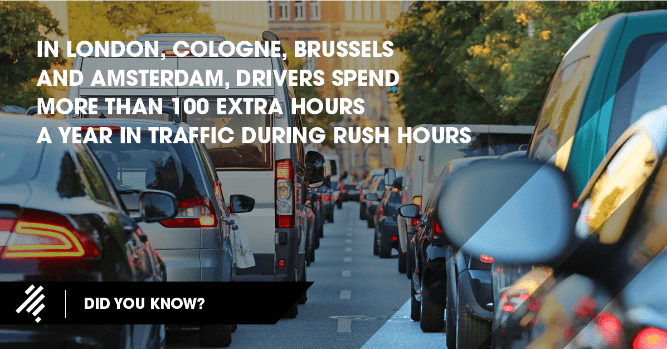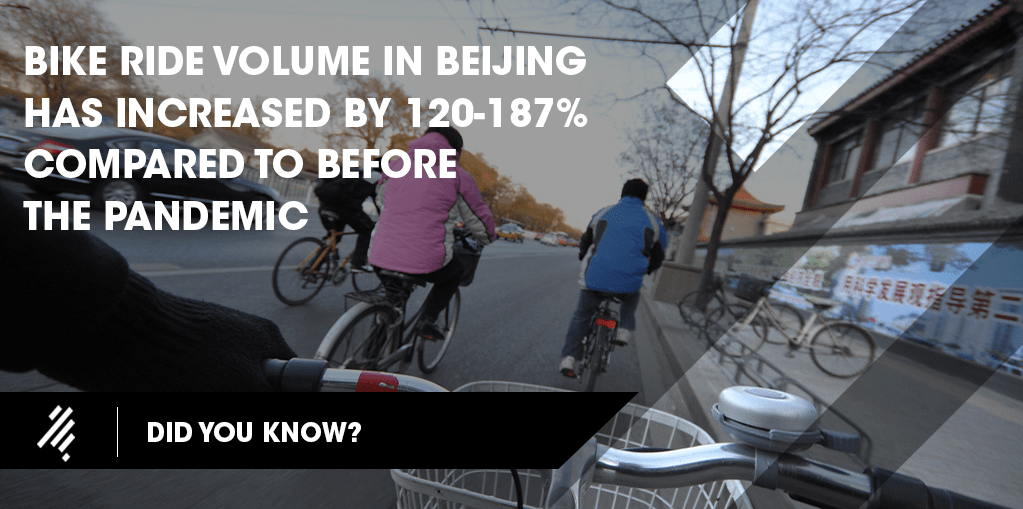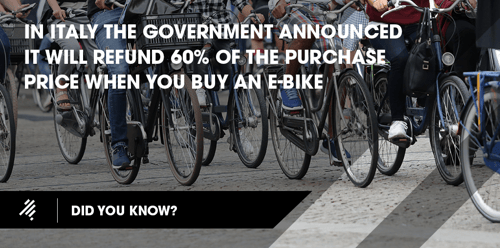Sustainable mobility: Is COVID-19 speeding it up or slowing it down?
Before COVID-19 urbanisation was one of the biggest challenges, roads were packed with cars and trains crammed with commuters during rush hour. A sense of urgency for sustainable mobility took hold and became a focal point for more mobility companies and governments. With the COVID-19 outbreak priorities seem to be shifting. So, is COVID-19 speeding up or slowing down sustainable mobility?
Sustainable mobility before COVID-19
Before the outbreak of this pandemic, sustainable mobility was on the agenda in both public and private sectors. Why goes to show in the facts. Congestion costed the EU an average of € 100 billion a year. And in some European cities drivers spent more than 100 extra hours a year in traffic. In the Netherlands 1.3 million people travelled by train on an average working day. Moreover, the ride sharing market was estimated to grow with 20% by 2025.

Impact of COVID-19 on our environment and mobility
Now what has changed after this virus outbreak? In March only 10% of those train travellers remained. Since the pandemic traffic in some countries decreased by 50%. More and more cities are converting on-street parking into bike lanes. In Italy government announced it will refund 60% of the purchase price when you by an e-bike. Cycling companies in Beijing experienced an increase of bike ride volume between 120-187%. 40% of the previous public transport users in China have switched to private car use. In March during lockdown data showed a 20-30% drop in toxic gas in large parts of China and in Italy.


Last April, Paris city planners announced to spend 300 million euros of their budget to improve cycling in the city. Recently, Paris’ socialist mayor Paris Anne Hidalgo was re-elected. She will proceed on turning her Paris into an ‘urban forest’, making it more cycling friendly and less accessible to cars.
France is an interesting case. Since the virus outbreak the demand for e-bikes in Paris grew. Car sales in France are plummeting, and the French government has been forced to introduce an 8 billion euro recovery plan to keep the sector afloat. Recently a TV commercial of a Dutch e-bike company was banned from French television because it was seen as discrediting the automobile sector. So how can we find the perfect cooperation between every mode of transport in an infrastructure in which they strengthen each other and are environmentally friendly at the same time?

Did you know?
Dutch e-bike company VanMoof recently started a TV commercial in the Netherlands, Germany and in France. In France the commercial was banned by the Autorité de Régulation Professionnelle de la Publicité (ARPP), because it was seen as discrediting the automobile sector. It ‘creates a climate of anxiety.’ Judge for yourself.
How ready are we now for sustainable mobility?
On the one hand COVID-19 seems to have speeded up the use of certain modalities contributing to sustainable mobility. While on the other hand the mobility sector is facing huge economic challenges with investments put on hold to contribute to that same sustainable mobility. It seems we are caught in two minds: economy and environment. So, should we reprioritise? Or should we make use of what we have learned now and make even better plans? Never waste a crisis.
First of all we have learned a lot about our mobility behaviour. In the past few months most of us have become accustomed to working from home. Working from home is the new modality. Something we discussed in our first and second webinar. 25% of people usually commuting by car, say they will work from home more often. People might choose to travel outside rush hours because they now know how to be flexible.

The following example shows how we have learned to be flexible. In the Netherlands capacity in public transport is a big challenge. Especially during rush hours the maximum was reached while the number of travellers was expected to increase by hundreds of thousands of people. For years public transport companies have been looking for a solution to spread travellers. The solution lied with students. 25% of the travellers during rush hours were students. Schedulers of public transport and higher education institutions finally figured out a way to let students attend lectures in flexible hours or digitally. This makes it less essential for them to travel during rush hours. Hopefully this encourages other travellers to take the bus/tram/train more often decreasing congestion and contributing to our environment. If we are willing and not afraid of contamination of course. Research by the Dutch railway organisation showed 30% of all public transport passengers don’t feel save enough in the train / bus / metro, until for instance a vaccine is found. The chairman of the industries association Pedro Peters likes to stay positive: ‘This also means 70% is willing to travel.’ That’s the spirit.
Let’s proceed on this discussion: Join our webinar on July 14
The pandemic challenges cities to quickly adapt their urban mobility systems to the new reality. There are major challenges, but there are also huge opportunities to accelerate sustainable urban mobility. In this challenging time, it is essential that local authorities get support to adapt to these new circumstances and to ensure that sustainable mobility is a priority in the recovery of COVID-19. During the next Intertraffic webinar Don Guikink of Breda University of Applied Sciences, Jill Warren of European Cyclist Federation and Giles Bailey of Vianova will share their views on how cities can respond to the changing modal shift and set long-term goals and ambitions for urban mobility.
The time is now to engage in Sustainable Urban Mobility
With mass transportation being considered a risky space for infection, local governments decided to pedestrianize streets, create temporary bike lanes or broaden existing bike lanes in cities such as New York, Berlin, Milan, Brussels, Barcelona, Paris, Vienna and Sydney. The relevant question now is whether we will be able to maintain sustainable mobility initiatives after lockdown restrictions are lifted when cities get through this moment, hoping for planners, public officials and citizens to recognise the advantages of having more room and infrastructure for alternative mobility. Don Guikink will dive into this question. He is senior lecturer and research manager at Breda University of Applied Sciences in the Netherlands since 2015 and owner of consultancy firm GUICK Capacity Building for Mobility. He has over 20 years’ experience in international cooperation in the field of urban and smart city planning and urban mobility, covering almost all EU countries, parts of China and India.
Rethinking mobility and encouraging cycling as resilient and healthy mode of transport
Social distancing measures have shed light on how crucial cycling is for providing a healthy, safe, reliable and fast transport option both for essential trips and outdoor exercise. With the progressive lifting of lockdown measures, more and more cities are showing strong leadership by reallocating public space to active mobility and governments around Europe are offering financial incentives to encourage cycling. If we want these changes to be a permanent part of the post-COVID-19 world, collaboration, strong political will and concrete action will be necessary. Jill Warren is CEO of the European Cyclists’ Foundation. The ECF issued a set of recommendations for European, national and local authorities to promote cycling, and has been tracking COVID related cycling improvements in cities, regions and countries throughout Europe in a dashboard.
Shared micro mobility: a potential or a threat?
Giles Bailey is an insightful thinker about business and societal challenges and the resulting need for organisational change and the Head of Policy & Partnerships at Vianova.io - a shared micro-mobility management business working in cities across Europe. First and last mile mobility solutions, such as offered by micro mobility, are increasingly being discussed and developed by cities across Europe to enhance the multi-modality of the transport system. If these services are to become a core part of the transport solution for a city, the accuracy of the deployment of the services must be understood and authorities must have the confidence that the service is meeting the stated needs and being managed effectively. As shared micro mobility has become an immediate user case, issues were being raised about real time management, development and then enforcement of regulations, and an understanding of how the market was changing. Vianova developed a protocol based on the need for cities, and operators, to have a basis for communicating and managing the potential growth of shared smaller vehicles in their cities. Giles Bailey will share his vision.
Share your story
Do you have an innovation, research results or an other interesting topic you would like to share with the professionals in the infrastructure, traffic management, safety, smart mobility and parking industry? The Intertraffic website and social media channels are a great platform to showcase your stories!
Please contact our Sr Brand Marketing Manager Carola Jansen-Young.
Are you an Intertraffic exhibitor?
Make sure you add your latest press releases to your Company Profile in the Exhibitor Portal for free exposure.





